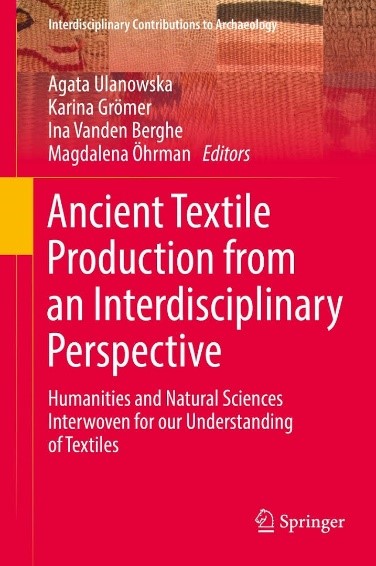Ancient Textile Production from an Interdisciplinary Approach: Humanities and Natural Sciences Interwoven for our Understanding of Textiles. By Karina Grömer

For decades, textile remains from archaeological contexts have come more and more into the focus of archaeological research. Recently, the book Ancient Textile Production from an Interdisciplinary Approach: Humanities and Natural Sciences Interwoven for our Understanding of Textiles, edited by Agata Ulanowska, Karina Grömer, Ina Vanden Berghe and Magdalena Öhrmann was published in the Springer’s series “Interdisciplinary Contributions to Archaeology” (2022). It derived from a session held at the European Archaeologists Association Conference in Bern 2019.
https://link.springer.com/book/10.1007/978-3-030-92170-5
The motivation of the book is to improve the understanding of the role of textile production and textile products in the history of humankind. Embedding finds and their context information into socio-economical and cultural discourse contributes to a cultural anthropology of textile use. For the pre- and protohistory periods of Central Europe, it is a challenge that textiles are among those organic materials that are rarely preserved due to the prevailing climatic conditions.
A wider goal was to present a comprehensive overview of the latest approaches and aims in archaeological textile research. In the last decades, standards have been set in studies on textile fibres, textile structures, dyes and textile tools. New methods for examining textile artefacts and tools have led to new ways of understanding textile craft in prehistoric and historic times – as well as their impact on economy, trade, social and cultural development. Textiles are of a wide interest to the general public, especially in areas related to reconstruction, costumes and ancient textile manufacturing methods. The inclusion of a range of specialists, including craftspeople and experimental archaeology has also led to new interpretations of the material evidence. The multidisciplinary studies of archaeozoological, archeobotanical, and geochemical environments and resources are also of interest in understanding the most optimal resource management methods concerning textiles. The book embraces different approaches from a wide geographical (focus on Europe and the Mediterranean, but also including Near East, Africa and Asia) and chronological breadth (from the Neolithic c. 6th millennium BC to the Medieval in mid 14th c. AD).
The Introduction of the book (p.6) summarises the scope: “The present volume is organised in four parts that, in our opinion, reflect the main areas of the textile research in 2020. After the two introductory chapters (Part I: About this Volume and Textile Research in 2020), follow three chapters referring to dyes and dyeing technology (Part II: Interdisciplinarity of Colour: Dye Analyses and Dyeing Technologies). Six chapters of Part III: Interdisciplinary Approaches to Textile Tools discuss textiles and textile production starting from the analyses of tools, both functional and symbolical, as e.g., the references to textile tools in literary texts. Archaeological and cultural contexts, as well as textile traditions are the main topic of six chapters in Part IV: Traditions and Contexts: Fibres, Fabrics, Techniques, Uses and Meanings. The last two chapters of part Part V: Digital Tools refer to the use of digital tools in textile research. Obviously, the scope of this volume cannot convey the entire research on textiles in the beginning of the 2020s, however, we believe that it offers an overview of the innovative approaches, as well as the established research standards and routines.”
Archaeological textile research is a heterogeneous and multi-disciplinary field. The establishment of specific research strategies to gain basic data, interpretation and contextualisation is vital. Within the scientific textile research community in Europe, especially in the last 20 years with major research projects, overview publications, series of edited volumes and monographs of on-site textile and tool related studies, techniques and theoretical background have been of great importance. We see future signs that even more stakeholders will be involved, nicely illustrated by the “EuroWeb – Europe Through Textiles: Network for an integrated and interdisciplinary Humanities” (CA19131)” project, funded by a COST Action between 2020-2024. This is an interdisciplinary network bringing together researchers from across the continent to re-write European history through textiles, using innovative approaches to explore textile heritage and to record traditional textile crafts while empowering craftspeople and promoting a new view of the enduring social, economic, and cultural importance of textiles and dress.